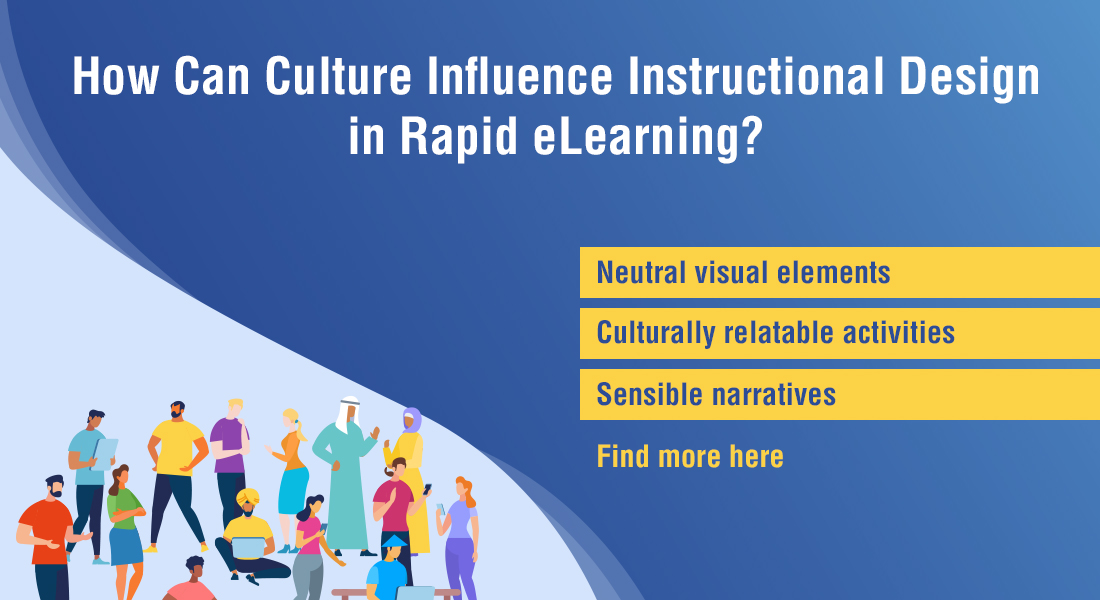Cultural Influences on Instructional Design – 4 Things to Remember

Do you want to increase the efficiency of your eLearning courses, but are worried about whether or not your learners will like what they see? You are not the only one concerned about the look and feel of your eLearning course. Culture – a factor that is frequently overlooked – plays an important role when it comes to instructional design in eLearning. Why, you ask? It’s because an eLearning course contains a variety of graphical, linguistic, and narrative elements that need to be customized for the target culture. Otherwise, there are chances of misinterpretation, leading to learner dissatisfaction.
4 Impacts of Culture on Instructional Design in eLearning
- Audio-Visual: Neutral audio-visual elements.
- Narrative: Culturally sensitive narratives and simulations.
- Interactivities: Culturally relevant activities and games.
- Tonal and Linguistic: Organizational culture compliant tone and language use.
This blog introduces you to the cultural constraints of instructional design in eLearning, and some tips about what to do and what not to do when it comes to designing eLearning courses in the context of cultural sensitivity.
Let’s get you kick-started on Rapid eLearning and why you should opt for it.
The Influence of Culture on Instructional Design – What to Remember
Instructional Design in eLearning refers to the systematic development of instruction and corporate training, by leveraging an effective mix of instructional theory and technology. It is a process of analyzing the training needs of learners followed by designing and developing suitable strategies to meet those requirements. It is while designing and implementing those practices and strategies, that culture becomes relevant.

While it is difficult to define culture in this context, it usually refers to the nuances of language and behavior of a group of people. How does that affect instructional design? Let’s see.
In corporate training, an eLearning course may be designed and developed for learners from diverse locations or a group of learners in a different country with a different cultural environment.
There are different instructional design strategies for developing eLearning for employees that involve different elements in the course – visual, audio, narrative, interactive elements, etc. Each of these elements may be influenced (sometimes quite profoundly) by the culture of that geographic location.
Let’s look at the different strategies employed by instructional designers and understand how culture can possibly affect them.
1. Cultural Influence of Audio-Visual Elements
An eLearning course is supported by a variety of visual elements that help learning. A case in question here is the Guided Learning where the learner is taken through the eLearning course by a character or avatar used as learning agents.
How these characters and avatars are displayed in the course is important. For instance, learners of Middle Eastern ethnicity may be put off by a course with elements that might appeal to a North American audience (showing the face of a female character may be considered insensitive). The same holds true if an avatar of a specific gender is used throughout the course. To ensure that you don’t step on any toes, keep the look and feel of the course as gender and culturally neutral as possible.

2. Cultural Influence of Narrative and Exploratory Elements
Learning happens when learners are exposed to different situations and scenarios which simulate real life problems, as seen in these four ID strategies:
- Scenario-Based Learning where learners are placed in situations where they need to take certain decisions in order to solve a problem.
- LEAD (Learning through Exploration and Discovery) which allows the learner to interact with the learning environment and discover new information.
- Case Studies where the learner has to apply his learning to a particular setting or context.
- Storytelling where learners learn about the subject through detailed narratives in the form of a story with a plot, a protagonist, a problem, and a purpose.
Developing a scenario-based learning module where the narrative is culturally insensitive can negatively impact learners. Thus, it needs extreme care and understanding of the target learner base and their culture before developing a narrative that can appeal to them.
If you are wondering how a simulated narrative can offend cultural sensitivities, here is a quick trivia. In countries like Russia, Greece, and parts of Africa, the thumbs-up is considered an offensive symbol. You see, Not Okay!
So, when you design a scenario-based course, you have to make sure that the overall narrative does not challenge or demean any culture. The best way to do that is to understand the learners’ cultural base, and avoid elements that would indicate cultural ignorance, negligence, or incompetency.
3. Cultural Influence of Interactive Elements
Gamified learning and simulations in eLearning courses ensure learner engagement and active learning.
- Game based learning uses elements of gamification to facilitate better learning and retention amongst learners, as well as nurture a competitive learning spirit.
- Simulations can be used to enable learners to practice their learning without the risk of real-life consequences.
Games and simulations need to be designed with the specific learner in mind. Including a simple game of trivia based on cricket in your eLearning course can appeal to a lot of learners, but definitely not those from North America, given cricket isn’t so popular there. Similarly, a course which uses ice hockey as the background for the games won’t be understood by audiences who haven’t seen a game of ice hockey in their life. Agreed, these cultural gaffes may not offend, but will certainly lead to learner disengagement.
4. Cultural Influence of Tonal and Linguistic Elements
An eLearning course has a lot of textual elements and culture could play a significant role here also.
The influence of culture also becomes visible in the tone and language being used. While some organizations prefer a formal tone of language that upholds corporate demeanor, other folks don’t mind a dash of humor in their training. Some prefer the language addressing learners in second person, while others prefer using first person to stand in the learners’ shoes themselves.
Organizational culture aside, even for courses that are being translated, it is important to remember that eLearning translation is not just the exact conversion of source words and phrases to the target language, it also carries over the meaning associated with the sentence. Here grammar, especially word order (order of subject, verb, and object is different is English and Japanese), as well as genders (even inanimate objects in French have genders), also affect the way the course is read and understood.
Wrapping It Up!
Confront, Complain and Conform – these are the three Cs that Norwegian public speaker and author, Julien S. Bourrelle introduced in his TEDx talk, ‘How Culture Drives Behaviors’, while explaining cultural diversity. He says that in a situation where you are exposed to an alien culture, you can react in one of the following three ways:
- You CONFRONT the person from the other culture, trying to devalue his/her principles and beliefs, considering yours to be the epitome of cultural supremacy.
- You COMPLAIN when the ideologies of the new culture clash with yours and end up isolating yourself into culturally idiosyncratic ‘Bubbles’ living within a larger society.
- You CONFORM when you understand the vastness of the cultures co-existing in this world, and align your behavior to adapt to that of the society you are within.
It is by conforming, by adapting your behavior in a manner that it parallels the cultural outlook of your host society, that you benefit the most. Keeping in mind all the tiny culturally sensitive details while designing a course can help create a bridge between you and your learners, instead of a wall.
Did this article make your gray matter run wild for a bit? There is a lot to explore in the organizational culture domain. If you keep an eye out, you will find more interesting and useful insights from me. Until then, keep busy with this eBook on instructional design for designing appealing eLearning courses.





